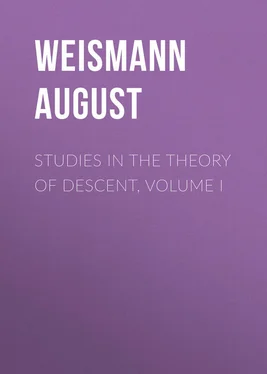August Weismann - Studies in the Theory of Descent, Volume I
Здесь есть возможность читать онлайн «August Weismann - Studies in the Theory of Descent, Volume I» — ознакомительный отрывок электронной книги совершенно бесплатно, а после прочтения отрывка купить полную версию. В некоторых случаях можно слушать аудио, скачать через торрент в формате fb2 и присутствует краткое содержание. Жанр: foreign_antique, foreign_prose, на английском языке. Описание произведения, (предисловие) а так же отзывы посетителей доступны на портале библиотеки ЛибКат.
- Название:Studies in the Theory of Descent, Volume I
- Автор:
- Жанр:
- Год:неизвестен
- ISBN:нет данных
- Рейтинг книги:4 / 5. Голосов: 1
-
Избранное:Добавить в избранное
- Отзывы:
-
Ваша оценка:
- 80
- 1
- 2
- 3
- 4
- 5
Studies in the Theory of Descent, Volume I: краткое содержание, описание и аннотация
Предлагаем к чтению аннотацию, описание, краткое содержание или предисловие (зависит от того, что написал сам автор книги «Studies in the Theory of Descent, Volume I»). Если вы не нашли необходимую информацию о книге — напишите в комментариях, мы постараемся отыскать её.
Studies in the Theory of Descent, Volume I — читать онлайн ознакомительный отрывок
Ниже представлен текст книги, разбитый по страницам. Система сохранения места последней прочитанной страницы, позволяет с удобством читать онлайн бесплатно книгу «Studies in the Theory of Descent, Volume I», без необходимости каждый раз заново искать на чём Вы остановились. Поставьте закладку, и сможете в любой момент перейти на страницу, на которой закончили чтение.
Интервал:
Закладка:
I have elsewhere 9 9 “Über den Einfluss der Isolirung auf die Artbildung.” Leipzig, 1872, pp. 55–62.
endeavoured to show that butterflies in general are not coloured protectively during flight, for the double reason that the colour of the background to which they are exposed continually changes, and because, even with the best adaptation to the background, the fluttering motion of the wings would betray them to the eyes of their enemies. 10 10 [Mr. A. R. Wallace maintains that the obscurely coloured females of those butterflies which possess brightly coloured males have been rendered inconspicuous by natural selection, owing to the greater need of protection by the former sex. See “Contributions to the Theory of Natural Selection,” London, 1870, pp. 112–114. It is now generally admitted that the underside of butterflies has undergone protectional adaptation; and many cases of local variation in the colour of the underside of the wings, in accordance with the nature of the soil, &c., are known. See, for instance, Mr. D. G. Rutherford on the colour-varieties of Aterica Meleagris (Proc. Ent. Soc. 1878, p. xlii.), and Mr. J. Jenner Weir on a similar phenomenon in Hipparchia Semele ( loc. cit. p. xlix.) R.M.]
I attempted also to prove at the same time that the diurnal Lepidoptera of our temperate zone have few enemies which pursue them when on the wing, but that they are subject to many attacks during their period of repose.
In support of this last statement I may here adduce an instance. In the summer of 1869 I placed about seventy specimens of Araschnia Prorsa in a spacious case, plentifully supplied with flowers. Although the insects found themselves quite at home, and settled about the flowers in very fine weather (one pair copulated, and the female laid eggs), yet I found some dead and mangled every morning. This decimation continued – many disappearing entirely without my being able to find their remains – until after the ninth day, when they had all, with one exception, been slain by their nocturnal foes – probably spiders and Opilionidæ .
Diurnal Lepidoptera in a position of rest are especially exposed to hostile attacks. In this position, as is well known, their wings are closed upright, and it is evident that the adaptational colours on the under side are displayed, as is most clearly shown by many of our native species. 11 11 [The fact that moths which, like the Geometræ, rest by day with the wings spread out, are protectively marked on the upper side, fully corroborates this statement. R.M.]
Now, the differences in the most pronounced cases of seasonal dimorphism – for example, in Araschnia Levana – are much less manifest on the under than on the upper side of the wing. The explanation by adaptation is therefore untenable; but I will not here pause to confute this view more completely, as I believe I shall be able to show the true cause of the phenomenon.
If seasonal dimorphism does not arise from the indirect influence of varying seasons of the year, it may result from the direct influence of the varying external conditions of life, which are, without doubt, different in the winter from those of the summer brood.
There are two prominent factors from which such an influence may be expected – temperature and duration of development, i.e., duration of the chrysalis period. The duration of the larval period need not engage our attention, as it is only very little shorter in the winter brood – at least, it was so with the species employed in the experiments.
Starting from these two points of view, I carried on experiments for a number of years, in order to find out whether the dual form of the species in question could be traced back to the direct action of the influences mentioned.
The first experiments were made with Araschnia Levana . From the eggs of the winter generation, which had emerged as butterflies in April, I bred caterpillars, and immediately after pupation placed them in a refrigerator, the temperature of the air of which was 8°-10° R. It appeared, however, that the development could not thus be retarded to any desired period by such a small diminution of temperature, for, when the box was taken out of the refrigerator after thirty-four days, all the butterflies, about forty in number, had emerged, many being dead, and others still living. The experiment was so far successful that, instead of the Prorsa form which might have been expected under ordinary circumstances, most of the butterflies emerged as the so-called Porima (Figs. 3, 4, 7, 8, and 9, Plate I Конец ознакомительного фрагмента. Текст предоставлен ООО «ЛитРес». Прочитайте эту книгу целиком, купив полную легальную версию на ЛитРес. Безопасно оплатить книгу можно банковской картой Visa, MasterCard, Maestro, со счета мобильного телефона, с платежного терминала, в салоне МТС или Связной, через PayPal, WebMoney, Яндекс.Деньги, QIWI Кошелек, бонусными картами или другим удобным Вам способом.
.); that is to say, in a form intermediate between Prorsa and Levana sometimes found in nature, and possessing more or less the marking of the former, but mixed with much of the yellow of Levana .
It should be here mentioned, that similar experiments were made in 1864 by George Dorfmeister, but unfortunately I did not get this information 12 12 “Über die Einwirkung verschiedener, während der Entwicklungsperioden angewendeter Wärmegrade auf die Färbung und Zeichnung der Schmetterlinge.” A communication to the Society of Natural Science of Steiermark, 1864.
until my own were nearly completed. In these well-conceived, but rather too complicated experiments, the author arrives at the conclusion “that temperature certainly affects the colouring, and through it the marking, of the future butterfly, and chiefly so during pupation.” By lowering the temperature of the air during a portion of the pupal period, the author was enabled to produce single specimens of Porima , but most of the butterflies retained the Prorsa form. Dorfmeister employed a temperature a little higher than I did in my first experiments, viz. 10°-11° R., and did not leave the pupæ long exposed, but after 5½-8 days removed them to a higher temperature. It was therefore evident that he produced transition forms in a few instances only, and that he never succeeded in bringing about a complete transformation of the summer into the winter form.
In my subsequent experiments I always exposed the pupæ to a temperature of 0°-1° R.; they were placed directly in the refrigerator, and taken out at the end of four weeks. I started with the idea that it was perhaps not so much the reduced temperature as the retardation of development which led to the transformation. But the first experiment had shown that the butterflies emerged between 8° and 10° R., and consequently that the development could not be retarded at this temperature.
A very different result was obtained from the experiment made at a lower temperature. 13 13 See Exp. 9, Appendix I .
Of twenty butterflies, fifteen had become transformed into Porima , and of these three appeared very similar to the winter form ( Levana ), differing only in the absence of the narrow blue marginal line, which is seldom absent in the true Levana . Five butterflies were uninfluenced by the cold, and remained unchanged, emerging as the ordinary summer form ( Prorsa ). It thus appeared from this experiment, that a large proportion of the butterflies inclined to the Levana form by exposure to a temperature of 0°-1° R. for four weeks, while in a few specimens the transformation into this form was nearly perfect.
Интервал:
Закладка:
Похожие книги на «Studies in the Theory of Descent, Volume I»
Представляем Вашему вниманию похожие книги на «Studies in the Theory of Descent, Volume I» списком для выбора. Мы отобрали схожую по названию и смыслу литературу в надежде предоставить читателям больше вариантов отыскать новые, интересные, ещё непрочитанные произведения.
Обсуждение, отзывы о книге «Studies in the Theory of Descent, Volume I» и просто собственные мнения читателей. Оставьте ваши комментарии, напишите, что Вы думаете о произведении, его смысле или главных героях. Укажите что конкретно понравилось, а что нет, и почему Вы так считаете.












